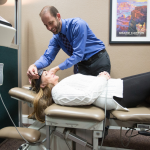How to Check Your Posture
Taking Inventory of Your Spine can Help Identify Issues Early
To avoid needless pain and suffering, one tip I often give is to take a postural inventory. A quick one-minute self-exam done daily is very helpful to allow one to be more aware of how their body is functioning. I like to instruct my patients to perform these every day, typically after they have warmed up in the morning – for example, after a shower. All you needed is a mirror.
Symmetry Check
Walk in place for a few seconds with the eyes closed. Open your eyes and look for right to left symmetry by answering these questions:
- Are the eyes, shoulders and hips level?
- Are the palms properly facing each other or turned in?
- Is the hip or head tilted to the side?
- From a profile view, are the shoulders drawn forward?
- Is the ear lined up with the shoulder, which is also lined up with the hip?
- Is there a forward pelvic positioning?
Theses static self checks are a great way to see where one is placing their weight, and can determine if the patient is compensating for poor posture dynamics. If you are experiencing misalignment in the Symmetry Check, it is time to make an appointment at NNC.
Range of Motion
Another easy check for postural health is to test your range of motion. It’s one thing to be out of pain, but are you able to fully utilize the entire function of the neck and back? Outside of avoiding stiffness, the ability to have full range of motion is vitally important in making us less vulnerable to injuries.
How to Check Range of Motion in the Neck
For the neck, the ability to rotate the head right and left with the chin nearly reaching the shoulder is normal. Lateral flexion of the head with the ear going towards the shoulders should be about 45 degrees. Proper neck flexion should be within one finger width of the chin to the chest. Extension (looking up) should be smooth and pain-free.
How to Check Range of Motion in the Back
The mid and lower back have less mobility, but should also be examined. Make sure that the mobility is not only full, but symmetric when turning or tilting to the right or left. Also, remember the pelvis and the lumbar spine are two different regions. Many people can bend and extend the lower back, but are unable to tilt their pelvis independently of the lumbar spine. This lack of motion in the pelvic region over time can lead to restrictive degenerative changes and possible disc disease.
If you are not able to complete these range of motion exercises with the neck or back, it is time to make your appointment with Northern Nevada Chiropractic so we can help get you moving again.
Self Assessment for Prevention
Just as a nice smile helps to show someone is healthy, good posture and symmetry has the same significance. These two checks will take less than a minute to perform, but are surprisingly helpful in determining proper spine mechanics. A quick daily mirror assessment is one of the best ways to prevent a lifetime of aches and pains.





